-
What are NDCs?
Nationally Determined Contributions (NDCs) are national climate action plans that form a central element of the Paris Agreement. They outline a country’s targets and actions to reduce greenhouse gas emissions and adapt to climate impacts, with the collective goal of limiting global temperature rise to well below 2°C while pursuing efforts to limit it to 1.5°C by the end of this century.
The NDC process operates on a five-year cycle for submission and updating. While earlier NDCs often laid out actions with a long-term view, many culminating in 2030 targets, the third round, due in 2025, is the first one to uniformly outline national climate actions with a specific and common implementation horizon through 2035.
This round represents a pivotal juncture, not just because it comes a decade after the Paris Agreement’s adoption, but because the window to limit global warming to 1.5°C is rapidly closing. The actions taken between 2025 and 2035 will be decisive in determining whether the world can meet this goal. Consequently, the level of ambition in these NDCs is a direct test of countries’ commitment to turning political promises into tangible emissions reductions. These updated plans are intended to outline increasingly ambitious action and coincide with the phase-out date for the sale of new combustion cars in several jurisdictions.
This cycle is also the first one to be informed by the Global Stocktake (GST), a comprehensive assessment of collective progress. The first GST process, which concluded in 2023, was based on commitments submitted in the run-up to COP26 in 2021. This stocktake underscored the significant gap between existing pledges and what is required to meet the Paris goals, adding further weight to the imperative for enhanced ambition in this round.
EV NDC World Map
Interactive map illustrating the global ambition to adopt electric vehicles (EVs), according to the Nationally Determined Contributions (NDCs) submitted by countries under the Paris Agreement.
Data current as of 15 October 2025
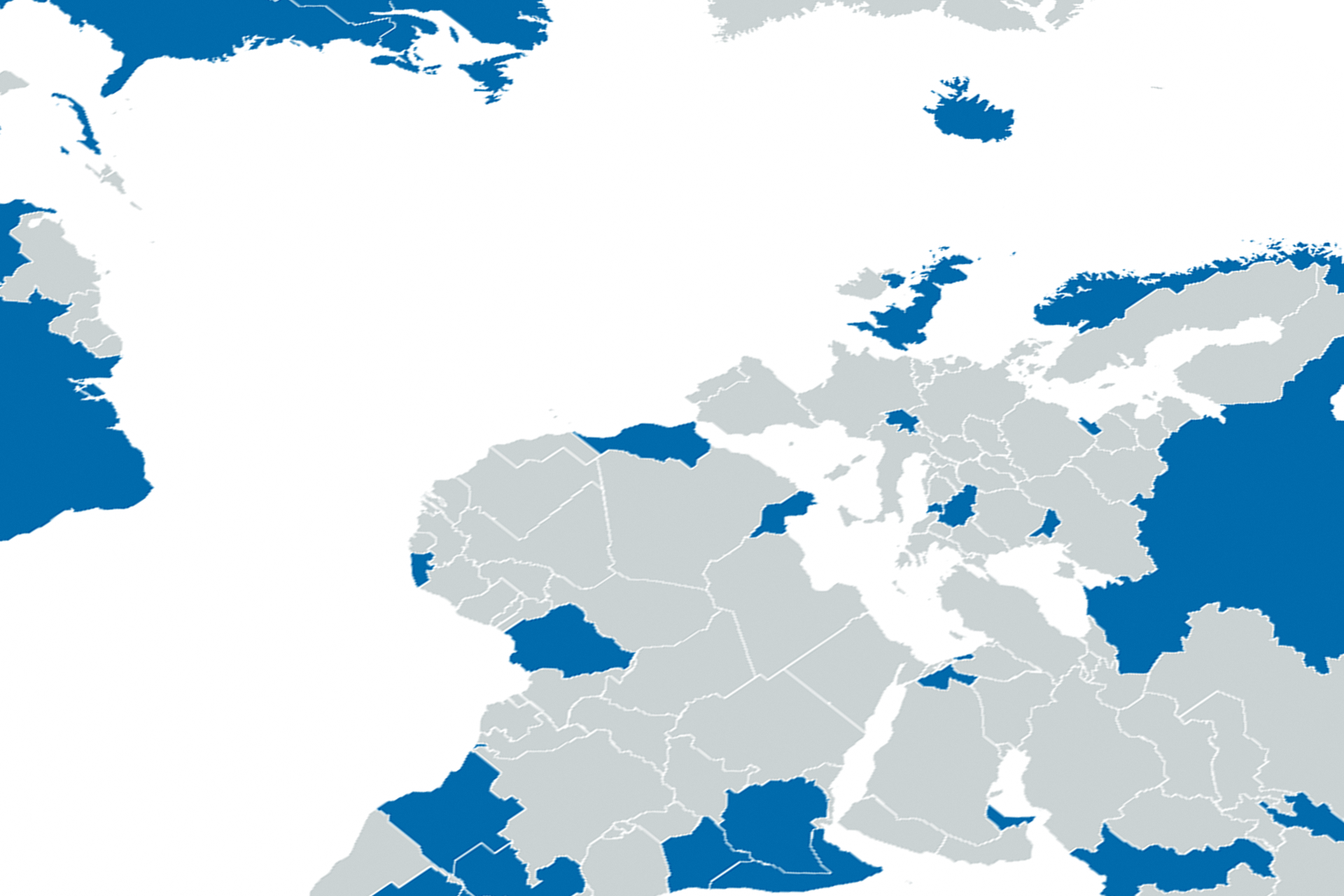
The EV NDC World Map
The EV NDC World Map illustrates the global ambition to adopt electric vehicles (EVs), according to the Nationally Determined Contributions (NDCs) submitted by countries under the Paris Agreement. The current edition of the map and the following analysis are based on the NDCs submitted until 15 October 2025, drawing from the data contained in the NDC Transport Tracker maintained by GIZ and SLOCAT (2025) (v. 4.0).
As of this cut-off date, 67 of the 195 parties had submitted their third NDC.[1] In the days preceding the opening of COP30, a dozen more parties submitted their national climate plans, including major emitters such as China and the European Union. These recent submissions have not yet been included into this analysis, which therefore represents a preliminary snapshot of ambition as of mid-October 2025. An update of this assessment including the NDCs published after October 15, will follow later this year.
Our aim is to provide a targeted overview of e-mobility in land transport, with the aim of assessing the level of ambition in the field internationally as well as identifying gaps in instruments and measures. This analysis seeks to provide input to both the e-mobility and climate communities, addressing shared priorities while also incorporating industry and climate concerns.
It is important to note that our analysis is based exclusively on the information contained within the submitted third-generation NDCs. Many countries have additional national strategies, targets, and measures detailed in dedicated policy documents, legislation, and national plans that may not be fully captured in their NDCs. Consequently, this review provides a specific window onto the commitments formalised within the United Nations Framework Convention on Climate Change (UNFCCC) process, which may not represent the entirety of a country’s national e-mobility landscape.
What are NDCs?
Why focus on electric mobility in transport?
-
Why focus on electric mobility in transport?
The transport sector represents a critical dimension of the global effort to mitigate climate change. As a primary contributor to greenhouse gas emissions, it accounts for nearly one-quarter of global energy-related CO₂ emissions, with road transport responsible for approximately 75% of that share. This significant emissions footprint underscores the urgent need for decarbonisation strategies that can deliver substantial and timely reductions.
Electric mobility stands out as a pivotal near-term strategy to achieve this goal. The International Transport Forum’s (ITF) Transport Outlook 2023 report identifies accelerated action on clean vehicles and fuels as the most impactful lever for decarbonisation. This lever accounts for three-quarters of the emission reductions between its Current Ambition and High Ambition scenarios.
Recent analysis from the International Council on Clean Transportation (ICCT) confirms that the transition to e-mobility is not just a theoretical potential, but is already underway, driven by concrete policy action. The ICCT’s Vision 2050 report shows that policies adopted in major economies over the past few years have significantly improved the emissions outlook, putting global road transport CO₂ emissions on track to peak as early as 2025.
However, this positive momentum should not taken as grounds for complacency. The same ICCT study serves as a crucial reminder that a significant gap remains between current policy commitments and a trajectory that is aligned with the goals of the Paris Agreement (see Figure 1). Thus, while progress is real, it is not yet sufficient. This underlines the critical need to not only maintain but drastically accelerate the ambition for e-mobility in national climate plans, including the upcoming round of NDCs.
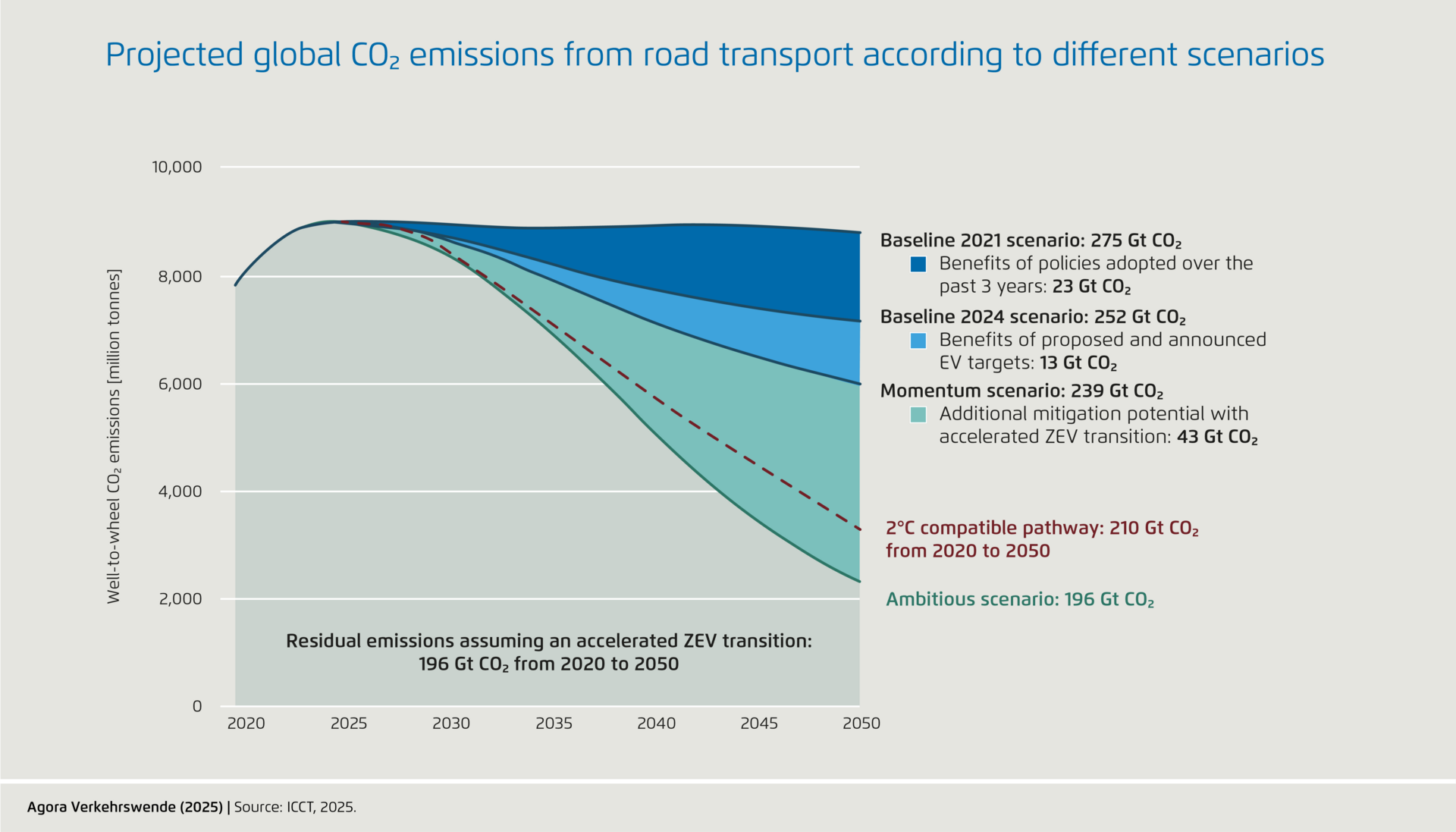
Early findings on NDC 3.0 submissions
-
Early findings on NDC 3.0 submissions
As of mid-October 2025, 67 countries have submitted their third NDCs. A broader view shows that 48 (72%) countries have incorporated some form of EV-related policies or measures, highlighting that while many governments are prioritising the sector, fewer are backing this focus with concrete, measurable targets. 28 (42%) have included specific electric mobility targets. This represents a significant increase of ambition, with 27% of countries with NDC 3.0 (18 countries) having introduced e-mobility goals for the first time, compared to their previous submissions. Our preliminary analysis shows a high number of small and developing nations among the early NDC 3.0 submissions with EV targets.
The list consists of: Angola, Bangladesh, Barbados, Belize, Bolivia, Cambodia, Canada, Colombia, Cuba, Eswatini, Ethiopia, Kyrgyzstan, Lesotho, Liberia, Mauritius, Moldova, Monaco, Nepal, Nigeria, Pakistan, Panama, Saint Lucia, Sao Tome and Principe, Solomon Islands, Sri Lanka, United Arab Emirates, the United Kingdom, and Vanuatu.

For developing countries and emerging economies, the NDC process is a critical channel for signalling climate priorities and accessing international support.
Among the 28 countries with specific EV targets, some nations stand out by presenting not just percentage targets for EV sales, but also broad vehicle-segment coverage. In addition, they show a commitment to complementary infrastructure and industrial policies, and have undertaken detailed financial planning. The next table shows five of the most ambitious nations in e-mobility among early NDC 3.0 submissions.
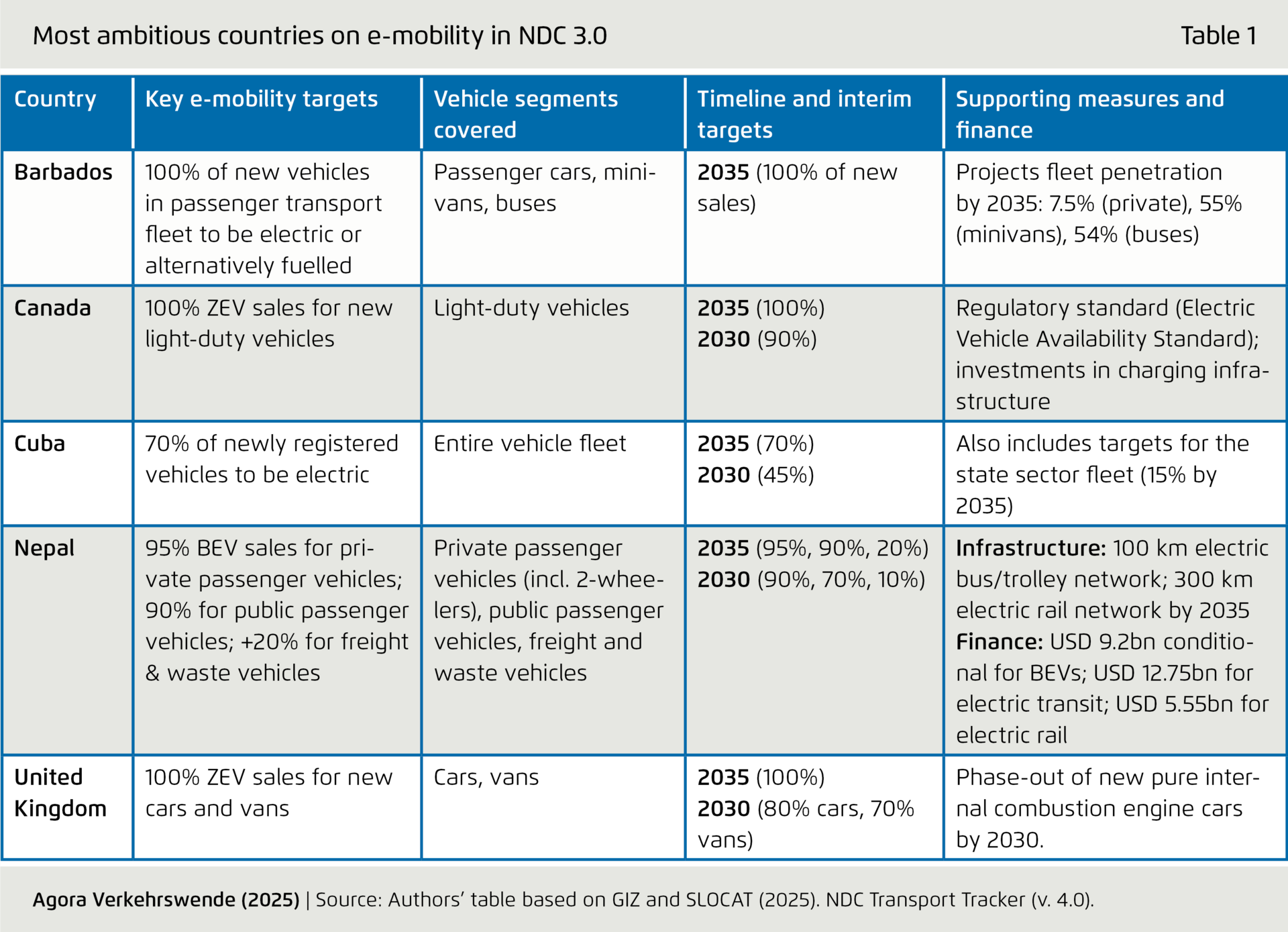
The standout commitments from Canada and the United Kingdom are their legislated phase-outs of new internal combustion engine vehicles, providing regulatory framework for a 100% zero-emission vehicles (ZEV) market by 2035. However, it must be noted that both governments have recently modified implementation in response to ongoing public discussion. Specifically, the federal government of Canada has delayed the start of its ZEV mandate by one year, pausing the 2026 target of 20% ZEV sales and initiating a 60-day review of the policy. This decision was attributed to trade pressures and a desire to reduce the burden on automakers. Meanwhile, the UK government has re-confirmed that from 2030, all new cars must be hybridised or zero-emission, explicitly allowing the sale of full hybrids (HEVs) and Plug-in Hybrids (PHEVs) alongside ZEVs until the 2035 deadline. These two cases highlight the dynamic nature of this transition.
Barbados matches this level of ambition with its 2035 100% EV mandate for new passenger vehicles. Cuba is aiming for 70% of newly registered vehicles across segments to be electric by 2035. Nepal emerges as perhaps the most remarkably ambitious developing economy. Its strategy encompasses nearly the entire transport ecosystem, from private cars and two-wheelers to public transport, freight, and waste collection vehicles. Crucially, Nepal backs its targets with quantified infrastructure projects and conditional financial plans, demonstrating a sophisticated and costed roadmap for implementation.
Regarding the vehicles segments, light-duty vehicles (LDVs) are the dominant focus among the 28 countries which have submitted NDCs 3.0 with e-mobility targets by mid-October (see next figure). Furthermore, charging infrastructure, which is a critical enabler of EV adoption, is notably absent from most plans. Only five countries (Ethiopia, Liberia, Pakistan, Sao Tome and Principe, and the United Arab Emirates) include specific targets for deploying charging stations.
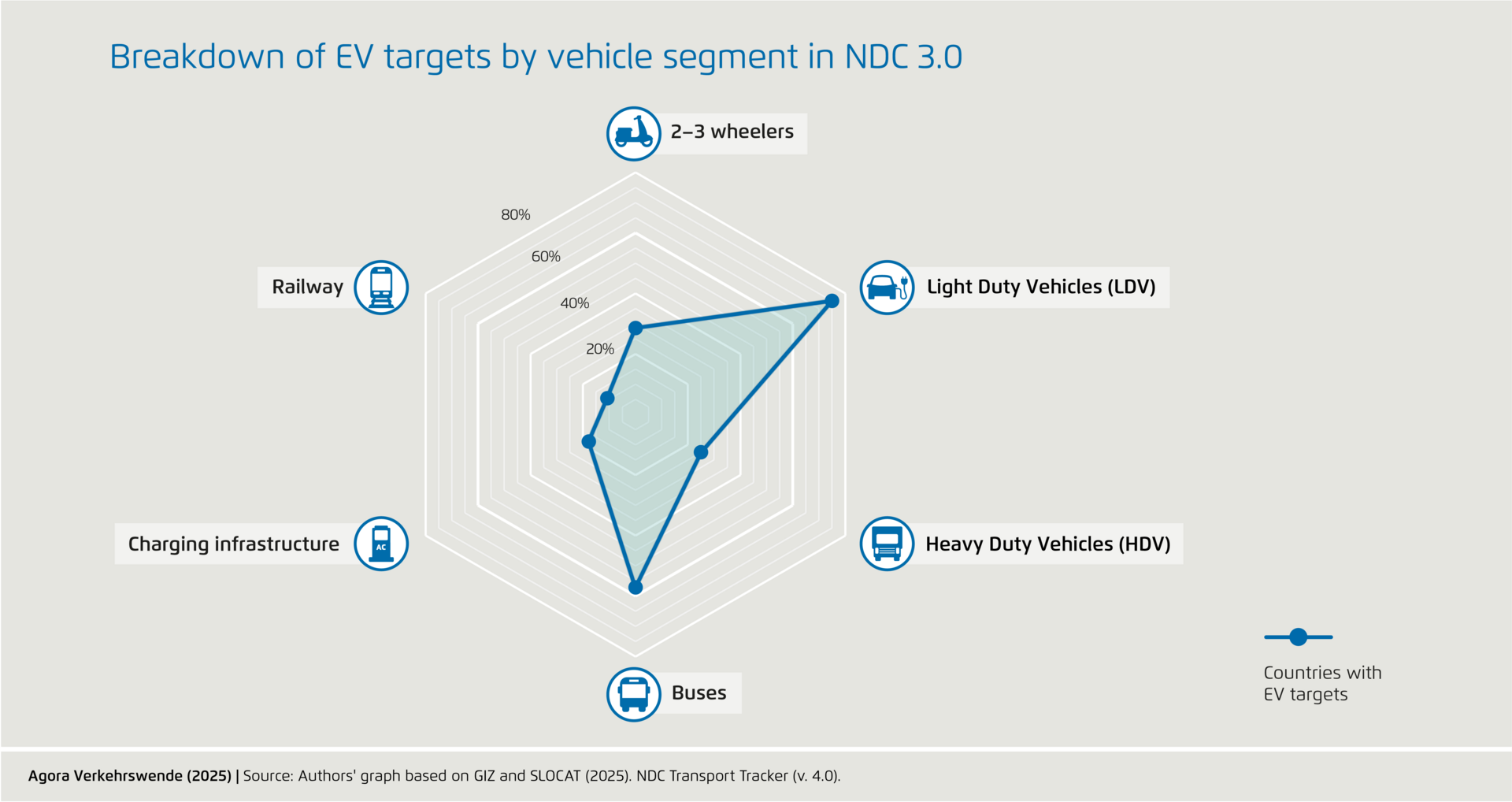
Comparing EV ambition in NDC 2.0 and 3.0
-
Comparing EV ambition in NDC 2.0 and 3.0
A comparative analysis with the previous NDC round reveals a landscape of growing ambition. There is a marked increase in specificity and scope between NDC 2.0 and NDC 3.0 for several nations. Countries like Nepal and Belize have evolved from general statements or single-measure approaches to comprehensive, multi-faceted strategies. Nepal, for instance, has not only increased its sales targets for public passenger vehicles from 60% to 90% by 2035 but has also introduced new targets for freight vehicles and detailed, costed infrastructure projects. This shift from vague policy intentions to measurable outcomes is a critical step for ensuring accountability and attracting investment.
However, this positive momentum is tempered by a countervailing trend of diminished ambition. Eight countries – Andorra, Chile, Honduras, Jordan, Seychelles, Singapore, Tonga, and Uruguay – had established specific EV targets in their NDC 2.0 that are now omitted from their NDC 3.0 submissions. For example, Chile’s has removed its previous target of achieving 100% electric taxis and public transport, while Singapore has omitted its commitment to phase out internal combustion engine vehicles by 2040. These commitments had previously sent clear and valuable signals to the market.
The following timetable provides a visual overview of national targets across all 28 countries with EV targets in the new round of NDCs.

Policies supporting EV market uptake
-
Policies supporting EV market uptake
Agora Verkehrswende’s analysis of electric mobility policies within the third round of NDCs was made considering the difference of national approaches: from highly specific and actionable measures to aspirational statements. By categorising these policies based on their concreteness and measurability, clear patterns emerge regarding the global readiness to implement a transition to zero-emission transport technologies. The submitted policies can be classified into three distinct tiers of commitment:
Concrete and actionable measures (Tier 1): These represent the most robust commitments, characterised by specific, quantitative targets and clear deadlines. Examples include Canada’s Zero-Emission Vehicle Availability Standard mandating 100% ZEV sales by 2035; Pakistan’s target for 30% of new vehicle sales to be electric by 2030, accompanied by a plan for 3,000 charging stations; and Liberia’s specific goal to deploy over 6,000 electric two and three-wheelers by 2035. These policies are tangible to track, hold governments accountable, and provide the clearest signals to the market.
Implementation-focused measures (Tier 2): This category comprises the majority of NDCs analysed. They describe a clear course of action but lack the specific numerical targets or firm deadlines that define Tier 1. For instance, Angola plans to develop nationwide charging infrastructure and launch pilot projects for electric buses, and Jordan is establishing a fast-charging network with tax incentives. While these pledges demonstrate a clear intent and a defined pathway, the absence of quantifiable outcomes makes it difficult to measure their direct impact and to hold countries to account in terms of implementation speed and scale.
Generic and aspirational declarations (Tier 3): These are declarations of intent without a concrete plan or measurable outcome. Policies from countries like Botswana (to “provide incentives”) and Brazil (to “replace fossil fuels with electricity”) fall into this category. While they indicate political support for the energy transition, clear adoption targets and metrics for verifying success are missing, thus instilling little confidence in meaningful policy execution or outcomes.
Among the 48 countries with any form of EV policy, there is a notable trend: some of the most comprehensive and actionable policy packages so far are emerging in developing nations. Countries like Nepal and Liberia outlined detailed plans that directly link infrastructure development to quantified vehicle adoption targets. Conversely, a significant number of commitments remain in the realm of generic and aspirational declarations. A particularly telling finding across the board is the widespread under-specification of charging infrastructure. With only a few exceptions, such as the UAE and Pakistan, most countries have yet to pair their vehicle adoption goals with specific, quantified targets for the indispensable charging network, revealing a potentially critical bottleneck for the envisioned rollout of electric mobility.
Alignment with existing international EV commitments
-
Alignment with existing international EV commitments
NDCs are being submitted in a context of existing international commitment within and beyond the UNFCCC. In the following, we assess the ambition of EV targets in NDC 3.0 in relation to Long-Term Strategies (LTS), which provide a mid-century vision, and the 2021 Zero Emission Vehicles (ZEV) Declaration, which sets a clear phase-out date for light-duty ICEV sales.
Alignment with Long-Term Strategies (LTS)
Parties to the Paris Agreement are invited to submit Long-term Strategies (LTS), or long-term low greenhouse gas emission development strategies, to complement the ten-year time horizon of NDCs with a long-term vision. They are a crucial indicator of countries’ commitments to reach net-zero GHG emissions by mid-century and thereby keep the Agreement’s targets within reach.
Of the 79 countries which have submitted LTS (most of them between 2020 and 2024), 29 include specific EV targets. The following table details how EV targets have been carried forward, or, in some cases, omitted, between a country’s LTS and its latest NDC.
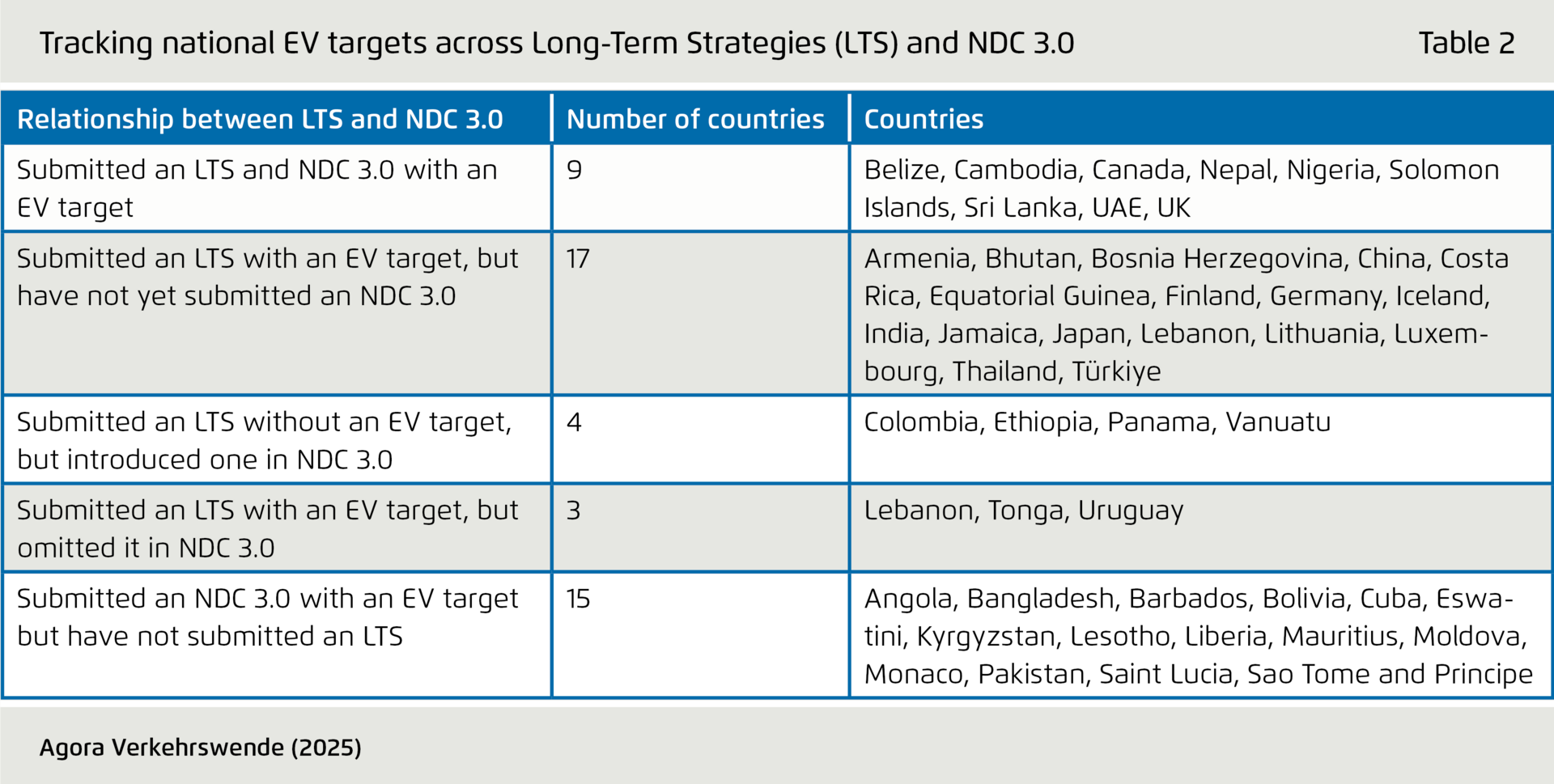
The majority of countries with an EV target in their LTS still need to submit their NDC 3.0. Among those that have submitted an NDC 3.0, the majority have confirmed and supplemented their EV targets. Only three countries have not maintained EV targets in their NDC 3.0. Canada’s NDC 3.0 reiterated the overall EV targets laid out in its LTS; however, it removed an intermediary 2030 target. The omission of previously stated LTS targets by three countries is a notable exception that warrants further monitoring to understand whether it signifies a shift in policy priorities.
Alignment with the Zero-Emission Vehicle (ZEV) Declaration
The ZEV Declaration, launched at COP26, aims for all sales of new cars and vans to be zero-emission by 2040 globally and by no later than 2035 in leading markets. In 2021, in Glasgow, 31 national governments signed the declaration, which marked a significant advance in the global phase-out of new sales of internal combustion engine vehicles (ICEV) in the light-duty segment. To date, 44 national governments have adopted the declaration.
In the second round of NDCs, the 17 EU member state signatories were the only ones to include a phase-out target compatible with the ZEV Declaration in their NDC 2.0. However, as the Declaration was launched within the second round of NDCs, many countries either had submitted their NDC before or only decided to sign up at a later stage. In this regard, the third NDC round can be seen as a litmus test for the implementation of the ZEV Declaration – as the Declaration’s first target year, 2035, coincides with the time horizon of the NDC 3.0.
Given that many signatories have yet to submit their NDCs, the current alignment between the ZEV Declaration and NDC 3.0s remains a partial picture. The Declaration's ultimate impact will only become clear as more countries translate this high-level pledge into concrete national climate plans, making it critical to continue monitoring them over the coming months.
This analysis provides a preliminary snapshot of e-mobility ambition based on NDCs submitted by mid-October 2025. As the remaining parties submit their climate plans in the lead-up to and during COP30, we will continue to track and integrate new data to provide an updated and complete assessment of the global landscape.
[1] Our analysis draws on the GIZ and SLOCAT NDC Transport Tracker, which considers all submissions from November 2024 onwards as third-generation NDCs (NDC 3.0). We maintain this classification throughout the report, acknowledging that it may lead to differences when compared to other NDC 3.0 trackers that employ alternative defining criteria.


